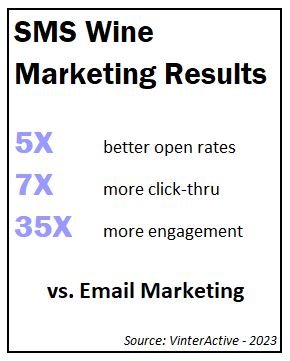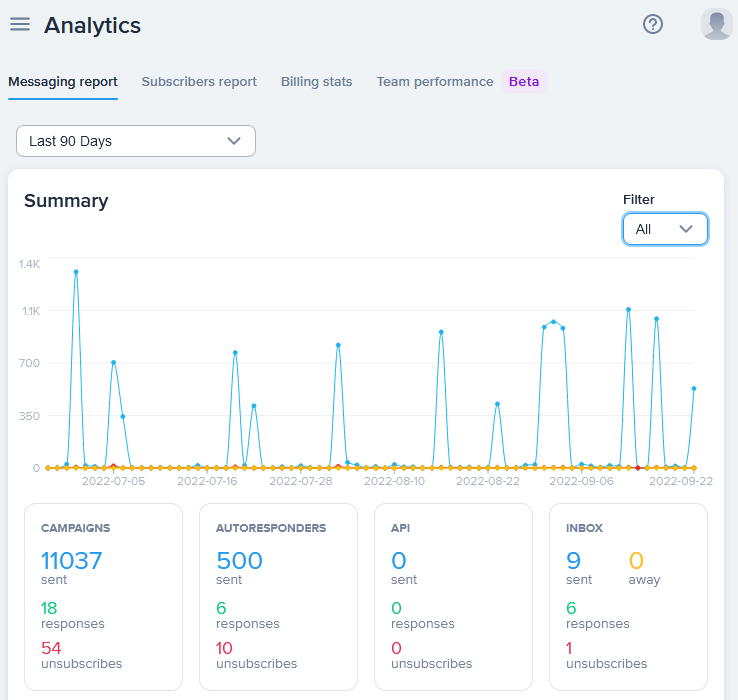Welcome to 2024!
If you have a strange feeling, “We’re not in Kansas anymore,” you’re not alone.
Consumer tastes have changed, new competitors are multiplying fast, and DTC wineries are now feeling the pain of declining sales and higher costs.
So, after the golden age of rinse-and-repeat digital marketing, it’s time to adapt.
The Untapped Potential of SMS Wine Marketing
One proven way for any winery to adapt is by engaging their customers with text messaging.
Text messaging has already eclipsed voice and email to become the most widely used communication method in the U.S.
And since fostering meaningful engagement with individual consumers is critical to the success of any DTC brand, 86% of today’s merchants have already adopted text messaging.
But in the wine industry, fewer than 14% of DTC wine brands have tried this approach, despite early adopters reporting astonishing results:
35X better customer engagement compared to email marketing
So why haven’t more wine marketers adopted this proven way to connect with consumers?
The Problem Facing Today’s DTC Wine Marketers
Unless you recently began your DTC career, you probably earned your stripes by mastering email marketing.
But email tactics invented twenty years ago – winery newsletters and email blasts – don’t translate well to SMS because they’re too impersonal.
So, today’s wine marketers now wrestle with new questions:
How do we build a responsive SMS list?
How often should we text our customers?
What messages should we send?
That’s why we developed a new paradigm for success, Preference-Based SMS Wine Marketing.
PRO-TIP: For more insight on what today’s consumers want from trusted wine brands, watch this free webinar presented by Susan DeMatei and Gaynor Strachan-Chun of WineGlass Marketing.
What is Preference-Based Marketing?
Preference-based marketing is hardly new.
Twenty years ago, leading brands learned that if they asked consumers about their interests and targeted their DTC marketing to address individual needs, customer engagement and sales spiked by 300-500%.
“Permission Marketing,” written by Seth Godin, became the bible for a generation of marketing managers. For national brands, preference-based marketing became a no-brainer decades ago.
But for most wine brands, the complexity and cost of preference-based marketing put it out of reach. Until now.
Why SMS is Perfect for Preference-Based Wine Marketing
Learning from the success and failures of email marketing, leading telecom providers – AT&T, Verizon, Comcast – made it much more difficult for spammers to ruin the profit potential of business texting.
In order to avoid the spam-ridden fate of email, the telecom industry first made sure consumers could confidently unsubscribe from SMS lists. Then, they made strict rules about acceptable text marketing behavior. And made it standard practice to vet every business planning to text their customers.
They also built a text messaging system that made it easy to collect consumer preferences and send personalized texts triggered by customer interest.
So in 2024, the powerful combination of low industry adoption and game-changing performance makes preference-based SMS marketing a unique opportunity for wine merchants not yet texting consumers.
4 Easy Steps to Profit from Preference-Based SMS Wine Marketing
If your wine brand is ready to delight consumers and sell more wine with text messaging, it’s easy and affordable to do.
After just a couple hours of planning, any wine merchant can launch their preference-based SMS wine marketing program in days by following these four steps:
Identify your customer’s primary interests
Grow a marketing list that captures customer preferences
Send a regular cadence of personalized messages
Measure and optimize results over time
Step 1 – Identify Your Customers’ Interests
This step doesn’t need to be complicated. Chances are, you already know what your customers are most interested in: your wine selection, wine tasting events, wine club updates, and the status of their wine orders. But if your winery offers unique experiences like tours, cooking classes, or live entertainment, you should add them to your list.
Step 2 – Grow an SMS List that Captures Customer Preference
Here’s where you’ll need help from an SMS service provider with experience serving the wine industry.
When shopping around, look for a vendor offering at least two ways consumers can opt-in to receive your texts:
Customized webforms that allow consumers to tell you what texts they want to receive
The ability to create keywords consumers can text you to indicate their SMS preferences
Webforms are most appropriate for websites that get their traffic from desktop visitors. But if most of your web traffic originates from mobile devices, SMS keywords are easier to use.
And, at your winetasting venues, QR codes linked to SMS keywords are the way to go since consumers can join your SMS list simply by scanning a code and pressing the “send” button on their phone.
PRO-TIP: If you use a single keyword like “wine” to subscribe customers to your SMS list, your welcome message can include additional keywords like “club news,” “order updates,” or “wine specials” to target your customers’ interests better.
Using hierarchical keywords to learn consumer preference is an easy way to build a preference-based SMS list.
Step 3 – Send Personalized Text Messages at a PREDICTABLE Pace
Once you have an opt-in list, it’s time to deliver relevant text messages. For best results, the timing of your messages should be determined by customer behavior and interests.
Transactional messages like order confirmation or shipping updates should be automated by linking your commerce system to your text messaging platform. For these messages, frequency is determined by customer behavior. Whenever a consumer opts in to receive order updates, they’ll expect you to text them every time they place an order.
You’ll be in charge of message cadence when consumers opt in to receive promotional messages about new releases or winery events.
A few wine merchants text their customers daily. If you offer consumers the option to receive texts about weekly tasting room specials, it’s up to you to deliver weekly texts.
But most consumers prefer a bi-weekly cadence of text messages from their favorite brands.
PRO-TIP: If your promotional texts are based on consumer preference, customer interests can drive message frequency. For example, if consumers can sign up for texts about new wines, tasting room specials, and upcoming cooking classes, you might send 1-to-3 promotional texts/month, depending on customer interests.
This approach takes the guesswork out of planning your SMS cadence.
Step 4 – Measure & Optimize YOUR SMS Wine Marketing Results
All direct marketing channels – from telesales, to email, and SMS – benefit from measurement and optimization. That’s why professional wine marketers put a premium on analytics and testing.
At a minimum, your SMS platform should automatically measure list growth, unsubscribe rates, and click-thru rates.
These metrics provide a baseline that can tell you the direct sales generated by every text you send.
Then once you have a baseline, the fun begins as you test different SMS offers and creative approaches to grow your list and better engage your customers, while minimizing unsubscribe rates.
Since SMS marketing is relatively new to both wine merchants and consumers, it might make sense to test offers that have worked well in other industries, including:
Contests
Birthday greetings
Automated welcome sequence
Abandoned cart reminders
MMS campaigns
PRO-TIP: If you ever question whether you should send a particular text to your list, follow the Golden Rule of SMS Marketing by asking yourself: would I send this message to a friend?
The Bottom Line
By all accounts, 2024 is shaping up to be a profound year of change for DTC wine marketers.
Some will resist, and many will observe, but forward-thinking merchants are already seizing the day by transforming every aspect of their marketing strategy to engage a new generation of wine consumers.
Central to our mission is the way we communicate with our customers.
Our best sales reps have always used customer preference to shape their pitch and sell more wine.
Now that consumers have embraced text messaging and wine merchants have affordable tools to personalize engagement based on customer interest, savvy brands are racing ahead to profit from preference-based SMS wine marketing.
The question you need to ask is whether you’ll join them before your competitors do?
ABOUT THE AUTHOR
Founder & CEO of VinterActive LLC, Bryan St. Amant, is a pioneer in developing preference-based direct marketing and its successful application in the wine industry.
His award-winning work has been featured in books, magazines, and seminars, including CFO Magazine, Inc., CNN Money, eMarketing Magazine, Integrated Direct Marketing, Direct Marketing Association, Wine Business, Grapevine Magazine, Wine Marketing Report, and the Wine Industry Network.











